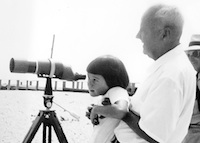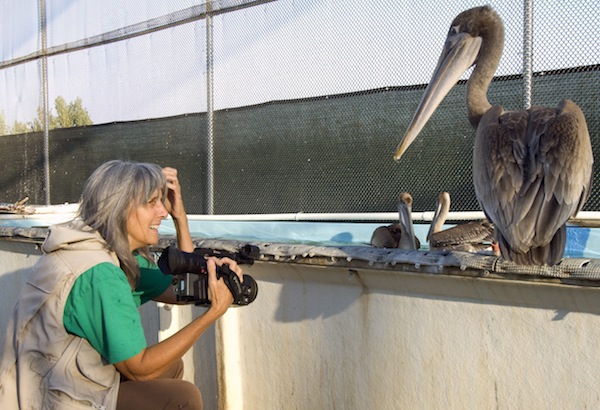San Francisco filmmaker Judy Irving may be best known for her award-winning documentary The Wild Parrots of Telegraph Hill, about a homeless street musician who befriends a flock of conures living in the trees in his neighborhood — but her heart belongs to pelicans. Irving’s lifelong love of the gawky but charismatic birds inspired her new film-in-progress Pelican Dreams, which follows the lives of several California brown pelicans — including one who was famously stranded on the Golden Gate Bridge — as they migrate up the California coast. We caught up with Judy during post-production to learn about her latest project.

You’ve migrated quite a bit yourself. Where did you grow up and what originally brought you to the Bay Area?
Irving: I grew up in suburban New Jersey across the river from New York City, and I graduated from Connecticut College with a degree in psychology. I worked as a freelance journalist for awhile, first in Montreal, then in British Columbia after hitchhiking across Canada. In the early ’70s I ended up living in a handmade raft house rent-free while trying to write and take pictures for a living, but after eight months I got a bad case of cabin fever and started yearning for a bathtub with warm running water.
I came south to the Bay Area to go to film school at Stanford, and I’ve been here in the Bay Area ever since. Getting into film school was a welcome escape from life on the road as well as the freelance writer career path. And film was a natural extension of my interest in still photography.
What kinds of films did you make before Parrots?
Irving: I’ve been making films for — believe it or not — forty years: documentaries about the wildlife and countryside of the Bay Area, the links between nuclear weapons and power, urban wildlife and charismatic urban humans, and a few fiction films.

What inspired you to do a film about pelicans?
Irving: I’ve loved pelicans since I first saw them in Florida when I was about five. As I got a little older, I started to think that I looked like one: I was tall and gawky too, and I have a long face. I’d actually started shooting a film about pelicans before the wild parrots flew into my life.
After that film was finished and out in the world, I had a chance to resume shooting my pelican movie. I love how graceful they are, and then, how clumsy. They look like flying dinosaurs. I’ve loved them for decades, but I knew very little about them before making this film. So I wondered whether it would be possible to actually get to know one. Pelican Dreams is my attempt to do so.
In the process, I learned a lot about their lives: from Baja to British Columbia, from oil spills to fishing-line injuries, from surfing wave crests to high-diving for fish. When a pelican’s life is good, it is very, very good. They are an ancient, resilient, relatively fearless, curious, funny, intelligent species.
Your grandfather was a great influence on your love for birds, wasn’t he?
Irving: He was an avid birder from the 1940s onward. Starting when I was about 5, he introduced me not only to outdoor birds via scopes and binoculars on our field trips on Long Island, but we also played a board game called “Bird Lotto,” where your knowledge of bird species helped you win. I was quite motivated to get good at that because I wanted to beat him. He also used to read to me a lot, and often the stories were about animals. I’m sure my love of birds and the outdoors came largely from him.
Please describe some of the greatest challenges you faced during the “Pelican Dreams” film project.
Irving: First, getting access to these birds: I wanted to get to “know” a pelican. But how can a person do that, without taming or otherwise harming it? California brown pelicans fly up and down the Pacific coast, and one of the challenges was finding places where I could get close to them while they nested and bred, dove for fish, surfed the wave crests, and soared in and out of the fog along the coast. I eventually did find some good locations: the Channel Islands; on the Columbia River, in Half Moon Bay, near Davenport, and at Pebble Beach.
Then there’s the matter of funding. It’s been tough, as usual, but enough has come in from foundations and individuals, in addition to support from our own nonprofit, to keep us going for the past five years, part-time. We still need to raise a significant amount for post-production expenses.
Did you actually get to know a particular pelican?
Irving: Yes, I made the acquaintance of two throughout the course of the production, “Gigi” and “Morro,” but I don’t want to give anything else away. You’ll have to see the film!
Where are you with the “Pelican Dreams” project?
Irving: It’s still a work-in-progress. I’ll be screening an 80-minute rough cut and asking for audience feedback on January 16th at the Bay Institute’s theater at Pier 39. Come and be part of the creative process!
As for finishing funds, I’ll continue to seek charitable donations from foundations and individuals, and in February, we’ll also launch a Kickstarter campaign. If all goes well I should have a finished feature-length documentary ready for festivals and distribution by next summer.
>> View the Pelican Dreams intro
What discoveries have you made while producing this film?
Irving: One thing that I knew almost nothing about before I started working on this movie is the vast, almost invisible, “underground railroad” of rehabilitators for sick and injured wildlife: It’s amazing how many people volunteer their time to rescue animals, take care of them, and then release them back to the wild. In addition to the seabird biologists who study pelicans and the fishermen who see them every day, the human stars of Pelican Dreams are several wildlife rehabbers who’ve devoted their lives to helping wild animals in distress. It’s inspiring.
What’s your favorite place to get outside in nature in the Bay Area?
Irving: My husband Mark and I almost always head north when we want to get out of town, to Point Reyes, Tomales Bay, Inverness. That whole area is pristine and peaceful, yet wild, and not too far away.
>> Judy will present a free rough-cut screening of “Pelican Dreams” and solicit audience feedback at the Bay Institute’s theater at Pier 39 on Thursday evening at 6:15 pm, January 16th. A Q&A and questionnaires will follow at 8:00 pm.
>> Follow the progress of Pelican Dreams and support the making of Judy’s new film by visiting her website: http://pelicanmedia.org.





